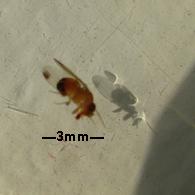Spotted Winged Drosophila (Drosophila suzukii)

Male SWD fruit fly, quite small, only 3mm in length, caught in cider vinegar trap.
Note black spots on wings, which are distinguishing characteristics of the male SWD.
Spotted Wing Drosophila Surveillance Program- Update June 22, 2021
- Spotted Wing Drosophila (SWD) surveillance traps have been set up at select southern Manitoba locations.
- Expect SWD population numbers to increase due to recent warm weather and as food sources for SWD from wild bush fruit hosts and ripening commercial berry fields start occurring in early July.
- Producers have many chemical control options to control SWD (see table links below).
- It is important to constantly rotate every application through different insecticide chemical groups to avoid potential insecticide resistance issues with SWD. Repeat with an alternate insecticide group type every 7-10 days.
- Berries are susceptible to SWD infestation from the start colour starts to appear on the berry all the way through harvest. No benefit to applying chemical controls before berries begin to colour up (ie. ripen).
Cultural Controls
- Harvest ripe berries frequently and cool berries quickly after harvest. SWD stop growing in the berry and eventually die at cool refrigerator temperatures.
- Keep raspberry rows more narrow to reduce favourable habitat for SWD.
- Remove unmarketable fruit and crush in alleyways.
Chemical Control
- Weekly application of approved insecticides are quite effective at controlling SWD and protecting the berry harvest from damage
- If SWD are present then control measures should start at same time as berries ripening colours start to occur.
- The following insecticide control options are a a guide only, always refer to the product label before applying the product. It is important to constantly rotate every application through different insecticide chemical groups to avoid potential insecticide resistance issues with SWD. Insecticide information from: OMAFRA
Manitoba Spotted Wing Drosophila Insecticide Products for Fruit Crops 2021
Manitoba Spotted Wing Drosophila Insecticide Products for Sour Cherry 2021
SWD Background Information
Spotted Winged Drosophila (Drosophila suzukii) (SWD) is a vinegar fly of East Asian origin that can cause damage to many soft skinned fruit crops. SWD pierces seemingly healthy fruit, and lays its eggs. The eggs hatch in about 3 days, the larvae feed on the fruit and emerge as adults after 6-28 days. Early detection is critical because symptoms often do not appear until after the fruit is harvested. Commonly confused with the common fruit fly, Drosophila melanogaster, SWD differs as it attacks unripe to ripe fruit, whereas the common fruit fly feeds on overripe and rotting fruit.
SWD most commonly affects raspberries, strawberries, saskatoons, cherries and plums. It was first identified in Manitoba in commercial berry fields in August, 2013.
The Prairie Fruit Growers Association and Manitoba Agriculture & Resource Development's Fruit Crops Program are working in collaboration on a SWD surveillance program for the 2021 field season to provide advance warning to commercial berry producers of the presence of SWD and when to start control applications.
Berry Salt Test for Larvae
Test berries for larvae using ¼ cup salt in 4 cups of water (1 part salt to 16 parts water), place ripe (but not overripe) berries in a pan with the salt solution, gently break-up the berries and look for small, white larvae to float in the solution.
Anthony.Mintenko@gov.mb.ca

